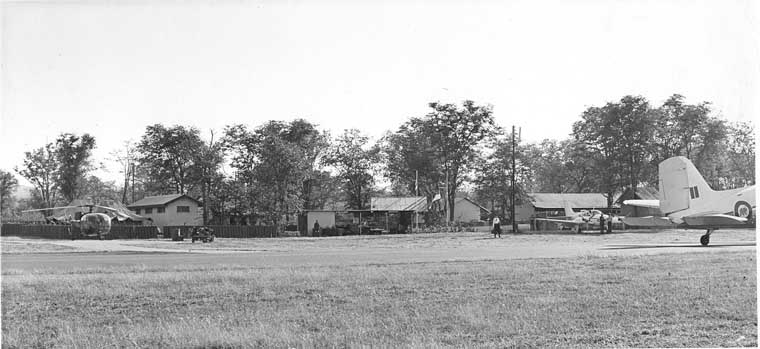Air Force Home Page A Brief History of the Rhodesian Air Force Flags and Symbols
Forward
Airfield | Location |
| FAF 1 | Wankie |
| FAF 2 | Kariba |
| FAF 3 | Centenary |
| FAF 4 | Mt. Darwin |
| FAF 5 | Mtoko |
| FAF 6 | Chipinga |
| FAF 7 | Buffalo Range |
| FAF 8 | Grand Reef |
| FAF 9 | Rutenga |
History of the FAFs
During the initial operations there were no permanent
forward airfields (FAFs) but it soon became evident that there was a need for permanent bases in the operational areas.
The first two to be established were FAF 1 at Wankie town in the west (12th August 1967), and FAF 2 at Kariba in the north.
Both of these airfields had hard surfaces. Kariba was a commercial air port
and therefore had proper Air Traffic Control and Metrological Services.
At each of these were based a fixed wing aircraft and a helicopter. In the beginning the senior pilot detached to the FAF acted as the FAF Commander during his detachment, but later a permanent commander with the rank of Squadron Leader was posted to these FAF's for a period of two years.
A Senior NCO detached to the FAF for a number of weeks was responsible for the every day running of the camp and territorial service men were used to guard the FAF.
The catering was carried out by a mess caterer detached from either New Sarum of Thornhill. He was the most important member of the team.
At the outset the personnel slept in tented accommodation but this was quickly changed to permanent structures and whilst not air conditioned the facilities were comfortable. Three hot meals a day were served and the beer was cold.
In 1972 at the commencement of Operation Hurricane, FAF3 was activated at Centenary airfield under the Command of Sqn Ldr Peter Cooke. Initially it has a grass airstrip but during 1973 the FAF was temporarily moved to the airstrip at Eureka Farm whilst the runway at Centenary converted to tarmac.
Later JOC Hurricane was moved from Centenary to Bindura.
Over a period of time Forward Airfields were established at Mt. Darwin, Mtoko, Chipinga, Buffalo Range, Grand Reef and Rutenga.
Because of the level of army activity the rank of the FAF commander was often that of Wing Commander.
The number and types of aircraft varied depending on operations at the time but in addition to Allouette III helicopters it was not uncommon to find Lynx, Cheetahs, Canberra and Dakota aircraft operating out of Forward Airfields.
During the rainy season of 1972/1973 the decision was made to lay a tarmac strip at Centenary. During this period the FAF was temporarily move a Eureka Farm strip. Operations returned to normal at FAF 3 in November 1973




















